In the first entry dated June 17 I mentioned that we visited an
outdoor museum in the little town of Sutton-Alpine on our trip from
Valdez to Anchorage. I found enough interesting things to photograph
that I decided to do a separate entry featuring the museum.
The little towns of Sutton and Alpine are located along the Glenn
Highway at MM 61 (i.e., 61 miles from Mile 0 in Anchorage). We read
about the historical park in The Milepost and wondered if we
could park our camper near it overnight.
We found a suitable place to park temporarily so we wandered around
the attractively-landscaped museum grounds for half an hour before supper:
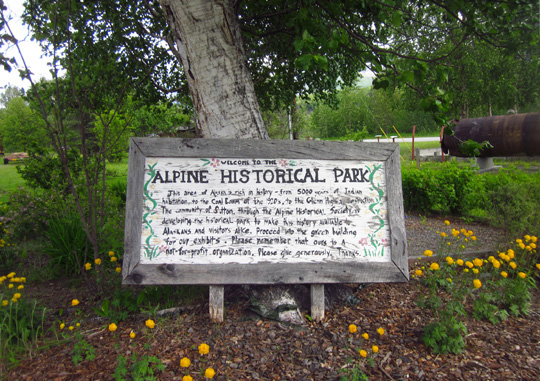
See next photo below to read this
sign.
However, we didn't see any place to stay overnight except the parking
area of the adjacent Post Office, which will be open tomorrow morning.
We drove back about a mile to a large turnout on the Glenn Hwy. for the
night.
If you're traveling in a small RV you could probably stay overnight
close to the museum.
This entry features some information and photos of the mining and cultural history
of the Sutton-Alpine community. An assortment of historic buildings and
equipment from three local coal mines (Sutton, Eska, and Chickaloon) and the
remains of the Sutton Coal Wash are located here.
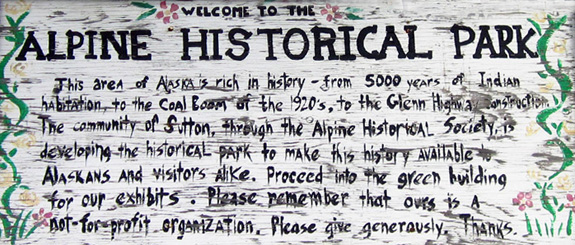
Let's start with the green building mentioned in the sign above, and
why it was built.
All the remaining historical information is from signs around the
museum grounds.
CHICKALOON BUNKHOUSE
This attractive building is the centerpiece of the museum, literally
in the middle of the grounds and the logical beginning of a self-guided
tour:
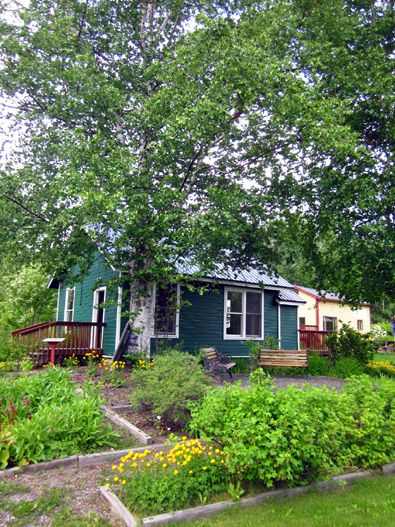
Here is its history:
In 1899 the U.S. Army documented the discovery of coal at nearby
Chickaloon. In 1916 the Interior Department set aside a designated coal
mining area. Soon the town of Chickaloon sprang up, populated by miners,
U. S. Navy personnel (not the Army??), and Native Ahtna Athabascan
people.
Within two years there were twenty-eight frame and log buildings in Chickaloon,
including a hospital, school, housing for the miners, and several
buildings for government personnel.
This bunkhouse was one of the government buildings.
Unfortunately, the boom at Chickaloon was short-lived. In 1922 the
Navy decided the coal was not of good enough quality to be used in naval
vessels and the mine was shut down. Within a decade the buildings were
dismantled and moved, the railroad tracks were torn up, and the town
declined. This bunkhouse was one of the buildings that was moved
-- more than once before it ended up here at the historical museum.
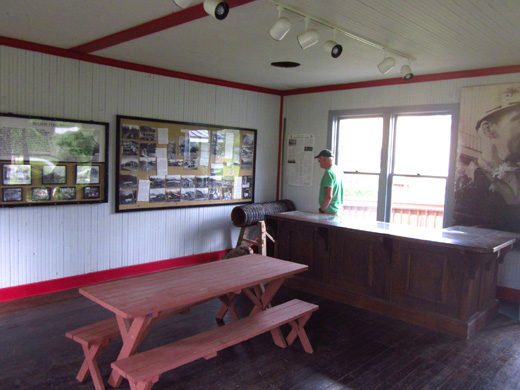
Jim examines historical photos and documents inside
the bunkhouse.
For several years the bunkhouse sheltered railroad and highway crews,
from eight to fourteen men at a time. Then it passed through several
individual owners before it was donated by one of them to the historical society in
1984.
OTHER HISTORICAL BUILDINGS ON-SITE
Several of the half-dozen buildings were open and had interpretive
panels.
Built about 1917, this house was the officers' quarters at Chickaloon.
After the town was abandoned two separate owners lived in it
near Palmer until it was donated to the historical society in 1989 and
moved to Alpine-Sutton:
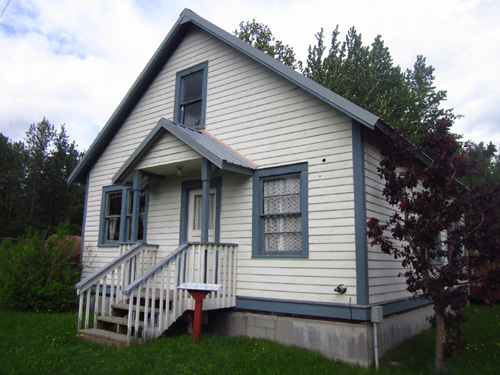
I don't remember what the gold-colored building was used for originally
(and didn't take a picture of the interpretive sign):
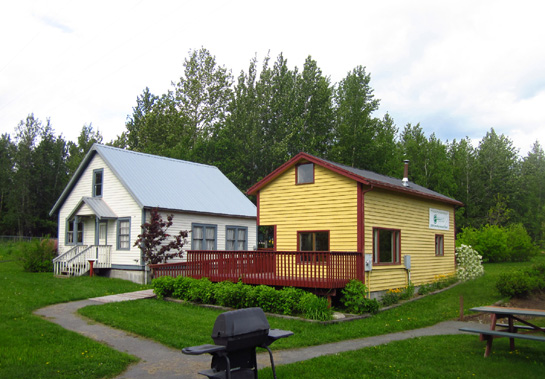
To the right of those buildings stands the original
Sutton Post Office, built in 1948 by the owner of the Alpine Inn. He
became the first postmaster till he moved to Anchorage and Grace Bouter
was appointed as the second postmaster:
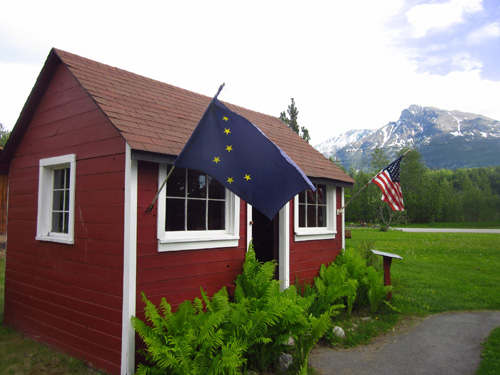
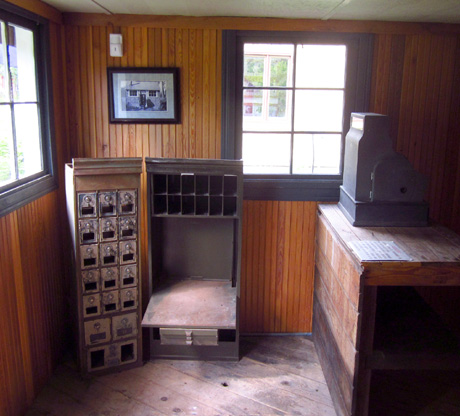
The little post office was so small it was used for only four years.
Grace Boutler recalls, "The place was so small,
around Christmastime I would have to take a couple bags of parcel post
and lock them in my car at night, because there was not enough room to
leave it in the post office."
A larger post
office was built nearby. This building was moved to its present location
in 1988.
I don't remember what this log building was originally used
for but it looks pretty snug:
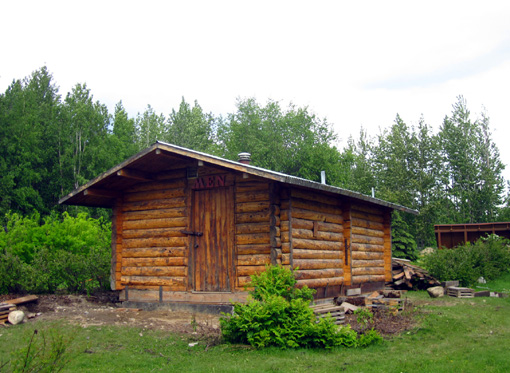
The next photo shows a "wall tent," an integral part of Alaskan
architecture since "Outsiders" first came to this area. From the gold rush
camps of the 1890s to modern-day fish camps, these semi-permanent tents
with wooden walls remain a standard of camp living in the Alaskan Bush:
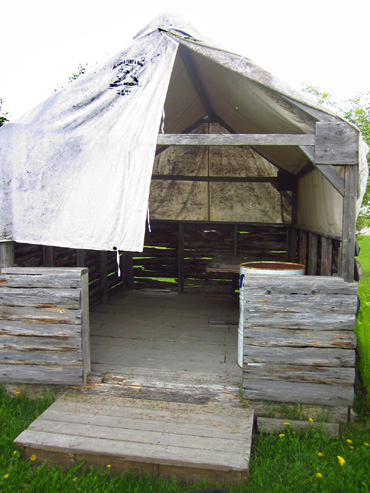
According to the interpretive panel, "Anchorage began as nothing more
than a collection of tents similar to this one when the Alaskan
Engineering Commission set up camp on Ship Creek in 1915 to begin
building the Alaska Railroad. The agricultural colonists President
Franklin D. Roosevelt sent to the Matanuska Valley during the Great
Depression lived in wall tents after they arrived in Palmer until they
were allotted a tract of land to farm and could build a house or cabin."
"Wall tents were also used in coal mining camps and for the
construction crews building the Glenn Highway. The tents are customarily
equipped with a stove for cooking and heating and remain quite
comfortable even in Alaska's winter temperatures."
I'm a weenie. I wouldn't want to test that theory in a flimsy structure
like that. I've already seen how cold it is around here in mid-June!
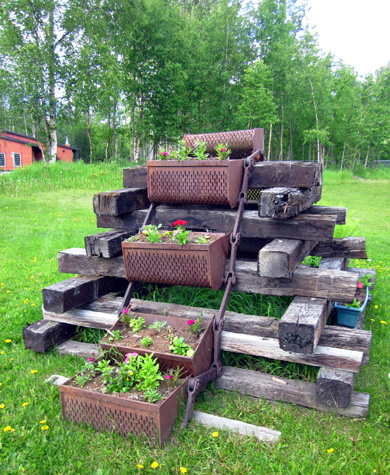
Old mining equipment used as flower pots at the
museum
Once we had read some of that history the ruins of the Sutton Coal
Wash and the assorted equipment on display from the Eska, Chickaloon,
and Sutton coal mines had more relevance.
SUTTON COAL WASH
I know next to nothing about coal mining so it was interesting to read
more about the washing operation on the interpretive panels around the museum
grounds. Who knew coal had to be washed?
Or dried,
for that matter?
The U. S. Navy was already involved with the Chickaloon
Coal Mine for several years when the coal wash was built in nearby
Sutton for military
use between 1920-1922. Two weeks after the coal wash was opened
the Navy decided it was no longer interested in Alaskan coal
because the quality wasn't high enough for naval vessels.
They couldn't
have figured this out before the washery was built??
The coal washing plant was closed for lack of business and usable
materials were dismantled and recycled for other purposes.
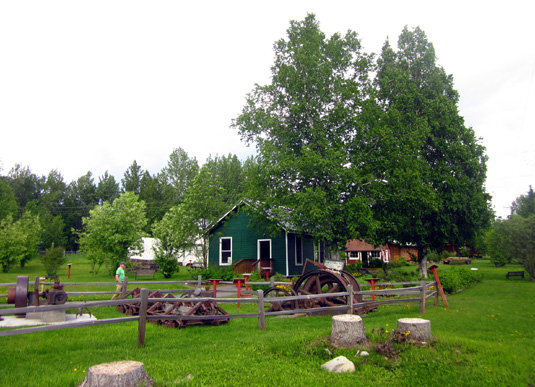
Jim examines some of the old mining equipment near
the bunkhouse.
The Sutton plant had two main structures -- a powder house and
a washer.
All that remains of those buildings are the concrete
foundations and supports, which you can see in the photos below:
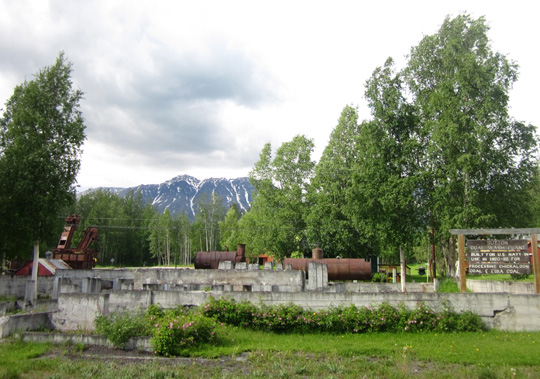
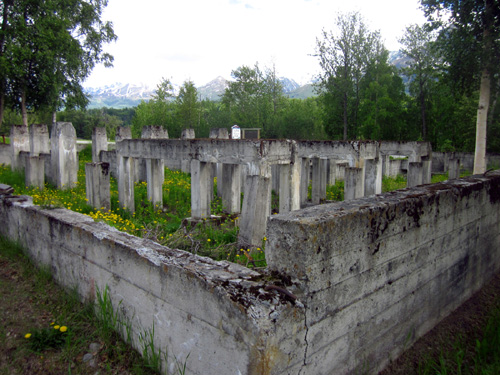
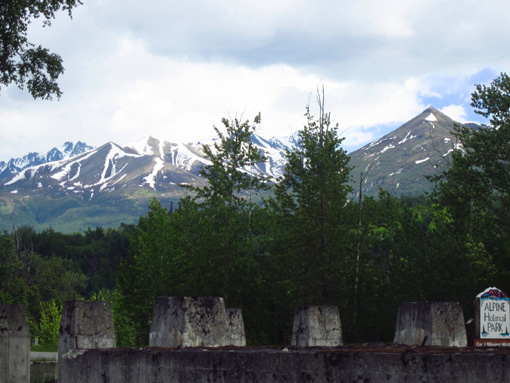
The plant was designed to wash a maximum of 1,250 tons of coal per 24
hours. Pipes were laid to deliver water to the plant for power and
washing the coal. Chutes were built to feed the coal into the washer and
four rail tracks were built to haul the material in and out.
Parts of these structures and other equipment from local mines are on
display at the museum.
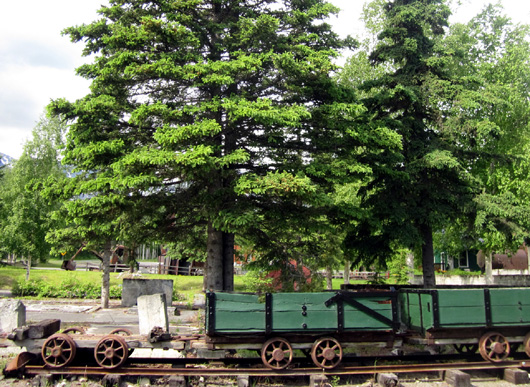
The next two photos show different views of the coal washer built in
1941 for the Eska Mine. It was housed in a large wooden building and had
catwalks surrounding it for easy maintenance by the workers.
Rock with coal in it was crushed by another machine and conveyed to the
washer, where three plungers similar to those used in today's washing
machines cleaned 25 tons of coal an hour. Agitation forced the
lighter-weight coal to float to the top and the heavier sedimentary rock
sank to the bottom. Then a large elevator hauled the washed coal to a
conveyor belt to the dryer and a smaller elevator carried the rejected
rock from the washer.
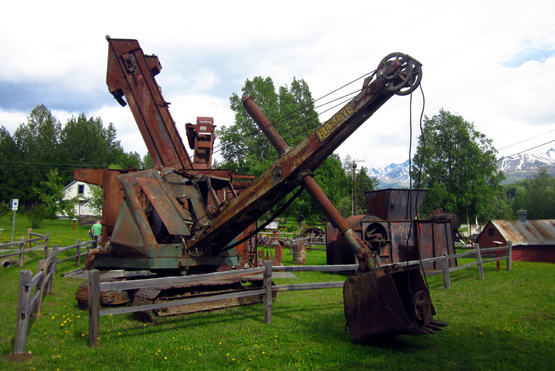

After going through the washing process, coal was conveyed on a belt to
a dryer. An eight-foot diameter metal dryer from the Eska Mine is shown
in the photo below:

This dryer had a motor in the top that produced a centrifugal force of
up to 1,850 revolutions per minute to reduce the moisture content of the
coal to 8 or 9%. The dry coal was removed by a chute under the dryer and
was conveyed to a storage bin.
Our self-tour of these grounds and buildings was interesting and
educational for both of us. Check it out if you're in the area.

Showy Cinquefoil flowers on the
museum grounds
There is no fee to wander around, just a
donation box near the entrance. No one else was on the grounds when we
visited so we let Cody explore with us while we absorbed some Alaskan
history at our own pace.
Next entry: the Musk Ox Farm near Palmer, one of
the original homesteading cooperatives in the Matanuska Valley
Happy trails,
Sue
"Runtrails & Company" - Sue Norwood, Jim O'Neil,
and Cody the ultra Lab
Previous
Next
© 2012 Sue Norwood and Jim O'Neil